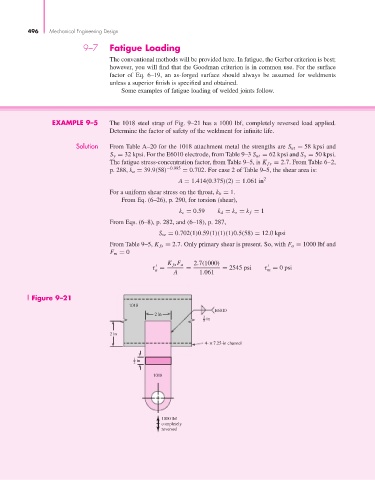Page 522 - Shigley's Mechanical Engineering Design
P. 522
bud29281_ch09_475-516.qxd 12/16/2009 7:13 pm Page 496 pinnacle 203:MHDQ196:bud29281:0073529281:bud29281_pagefiles:
496 Mechanical Engineering Design
9–7 Fatigue Loading
The conventional methods will be provided here. In fatigue, the Gerber criterion is best;
however, you will find that the Goodman criterion is in common use. For the surface
factor of Eq. 6–19, an as-forged surface should always be assumed for weldments
unless a superior finish is specified and obtained.
Some examples of fatigue loading of welded joints follow.
EXAMPLE 9–5 The 1018 steel strap of Fig. 9–21 has a 1000 lbf, completely reversed load applied.
Determine the factor of safety of the weldment for infinite life.
Solution From Table A–20 for the 1018 attachment metal the strengths are S ut = 58 kpsi and
S y = 32 kpsi. For the E6010 electrode, from Table 9–3 S ut = 62 kpsi and S y = 50 kpsi.
The fatigue stress-concentration factor, from Table 9–5, is K fs = 2.7. From Table 6–2,
p. 288, k a = 39.9(58) −0.995 = 0.702. For case 2 of Table 9–5, the shear area is:
A = 1.414(0.375)(2) = 1.061 in 2
For a uniform shear stress on the throat, k b = 1.
From Eq. (6–26), p. 290, for torsion (shear),
k c = 0.59 k d = k e = k f = 1
From Eqs. (6–8), p. 282, and (6–18), p. 287,
S se = 0.702(1)0.59(1)(1)(1)0.5(58) = 12.0 kpsi
From Table 9–5, K fs = 2.7. Only primary shear is present. So, with F a = 1000 lbf and
F m = 0
K fs F a 2.7(1000)
= 2545 psi τ = 0 psi
τ = =
a m
A 1.061
Figure 9–21
1018
E6010
2 in
3 in
8
2 in
4- × 7.25-in channel
1 in
2
1018
1000 lbf
completely
reversed

